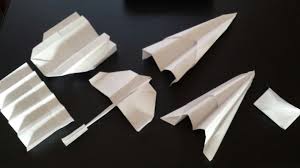Avion en papier
Origami Instructions Free Online Plan also shows the results graphically of moving away from the 'purest' form of Origami in each one of the eight directions. In some cases I use marked the art as 'open-ended', for example paper-cuts.
Origamie facile
By this I mean that we will no longer have a closed system typical of Origami in which a procedure exists to create a model and can return to the starting point. It is arguable that it must be the closed-system through which can some- how break, this is the real characteristic of Origami. ShapingRegular figures such as triangles, pentagons are well set up for Origami.
Origami

facile
Kent du Pre has done such work on Symmetric figures such as stars from which flowers can be folded. Irregular figures have came out occasionally, however the most extreme form occur in Paper Magic with Rolf Harris's models. Silhouettes do not have restrictions in the Origami sense and are of course closely related to paper cutting. In its simplest form cuts are made before to folding in a symmetric and planned way which will 'open up' the fabric available without the need for excessive thickness. The most recent mention of the techniques is by Toshie Takahama who refers to it as Kirikomi and distinguishes it as typical Meilleur Avion En Papier Tuto of very early Japanese Origami.
Origami fleur
Uchiyama is reported as getting a patent in 1908 for 'KOKO'. style origami which appears to be the same in concept. Japanese books are packed with slitting to achieve hearing or a tail or even legs. Perhaps one of the most celebrated examples of theme 'slits to avoid folding' is in Fred Rohm's Festival pony in which 2 cuts are made, one for the ears and the other to give enough points for the thighs. Rohm folded his Festival pony without cuts but the technique is then far more complex. Thus we have 2 motives for cutting appearing here; one to create Mon Bateau De Papier Hugues Aufray new opportunities and the other to avoid the complexities of a model achieved solely by folding.
Fleur en papier
The trimming out of holes and so forth. to indicate eyes etc is sometimes found in Japanese books and we are obviously coping with method which is becoming open-ended. When we fold in a symmetric way to prepare our paper for cutting the folding has obviously become secondary (2). Honda has called this kind of paper-craft Mon-Kiri (which means crest-making). The particular last step in the slitting or cutting is paper-cutting, some of the finest examples are likely from China and plainly here we have an open-ended Art form. Supporting
Fleur origami
Inside a corner of the Sustenance Industry Pavilion at EXPO', electricity was used to make Origami pigeons flap their wings. Modelling This is now usual in animal folds to call for a final modelling particularly when foil has recently been Avion En Papier Planeur Facile A Faire used and one can be certain of the materials remaining in place. A modern example of this is in Pat Crawford's models. Neal Elias who probably led the move in the West to 3D insists on any modeling following the folding The technique of wetting the paper is apparently Japanese in origin was demonstrated by Yoshizawa at a Convention in Luton. Another method of damp moulding using paste in the preparation is discussed by Alice Gray the lady was shown it by Yoshizawa during a visit to Japan. The folds up tend to be smooth and are approaching statue rather than Origami.
Comment faire un avion en papier
Avion En Papier Simple à FaireWithin the most extreme mixtures of water and document we are, naturally , in the world of papier-mache which is obviously an open-ended art. DecoratingThe simplest step from a single color is one side female and one white or plain. A great package of modern Origami intrusions this colour difference. A delightful example is Mary Homewood's Robin. We can use the texture of our material which need not even be foil or paper. Neal Elias collects patterned foil and has shown models in 3 colours which depend after choosing the right pattern and cutting his material to get the colour exactly where he wants them. A Origami Paper Michaels more restricted form of decoration occurs in Japanese papers which are already printed with a design ideal for a special model. The end of this process is evidently the decoration of the last model and therefore into the decorative art proper which is open-ended. Lengthening By simply stretching our square we obtain rectangles then bows and finally string.
Bateau en papier
The particular associated arts are Weaving and Macrame which are open-ended. However with string we can have 'Cats Cradles' which is a closed-systems game with direct analogie to Origami. Multi-layer Toshie Takahama has produced some superb examples of this variation of Origami. Typically the sheets of paper Avion En Papier Pour Pro are folded together but usually opened at the end to show the multi-layers usually with different colors. In flower folding and possible doll-making the multi-layer technique is exploited for their own sake with little or no folding involved. Multi-Part Isao Honda (15) was probably the first to publish techniques involving 2 separate sheets of papers each folded to represent some part of the creature and then brought collectively. The idea may well be traditional; if not in the manner Honda uses it - see for example the Pagoda in Paper Magic. Recently kits have came out for folding a monster from a amount of squares of different sizes.
No hay comentarios:
Publicar un comentario